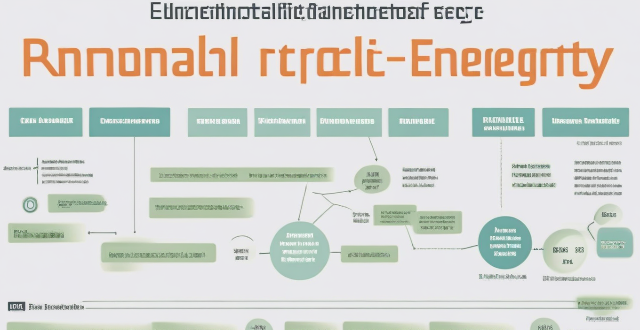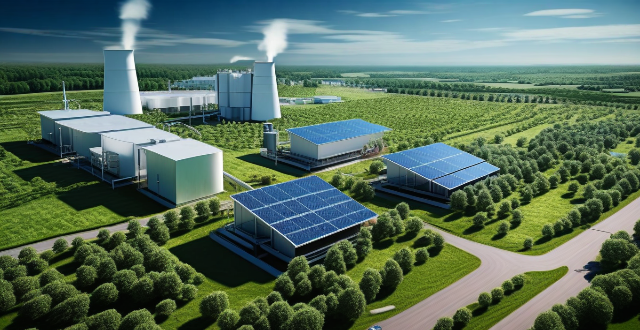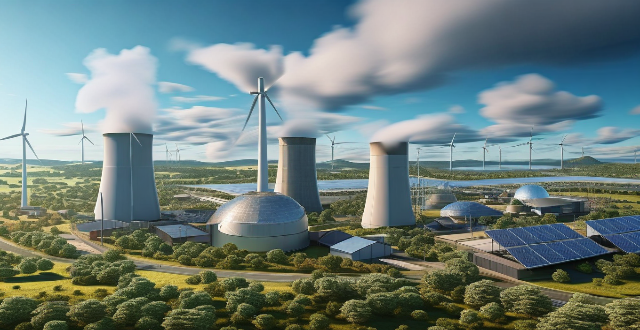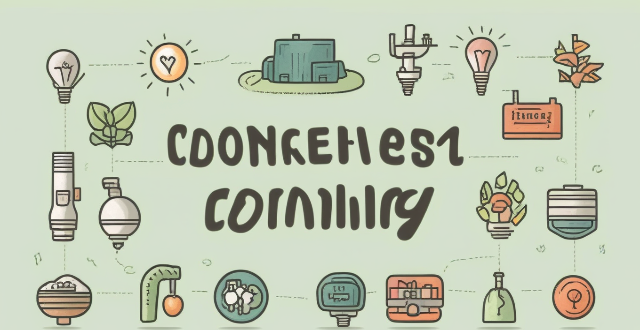Fund Energy

How do I choose a sustainable investment fund ?
Choosing a sustainable investment fund requires careful consideration of various factors, including your investment goals, the fund's ESG criteria and performance history, the experience of the fund manager, the fund's holdings and alignment with your values, fees and expenses, and ongoing monitoring of your investment. By following these steps, you can select a sustainable fund that aligns with your financial goals and personal values.

How can climate finance be leveraged to support renewable energy projects ?
Climate finance plays a crucial role in supporting renewable energy projects. Here are some ways to leverage it: 1. Public-Private Partnerships (PPPs) can be used to attract private investment into renewable energy projects. 2. Green Bonds can be issued to fund environmentally friendly projects such as solar and wind farms. 3. Carbon Pricing Mechanisms can generate revenue that can be invested in renewable energy projects. 4. International Climate Finance Initiatives can provide funding for renewable energy projects in developing countries. 5. Crowdfunding Platforms offer another way to raise funds for renewable energy projects. By using a combination of these strategies, we can accelerate the transition towards a more sustainable future.

What is the difference between a fixed deposit and a mutual fund ?
Fixed deposits offer guaranteed returns and low risk but limited growth potential, while mutual funds provide higher growth potential through diversified portfolios but carry more risk.

How do international climate agreements influence national policies on renewable energy ?
International climate agreements significantly shape national renewable energy policies by setting targets, offering financial aid and technology transfer, promoting innovation and collaboration, and creating market opportunities. This influence is evident in countries' ambitious renewable energy goals, their participation in global initiatives, and the growth of related industries. Such concerted efforts are crucial for achieving a sustainable, low-carbon future.

How can individuals invest in clean energy projects ?
Investing in clean energy projects is a way to support sustainable development and fight climate change. Individuals can invest through renewable energy mutual funds, green bonds, direct investment in clean energy companies, community solar projects, and sustainable real estate investments. Examples include iShares Global Clean Energy ETF (ICLN), Toyota Green Bond, and Eco-friendly apartment complexes.

How can governments fund economic stimulus plans effectively ?
Governments can fund economic stimulus plans through increased government spending, tax cuts, issuing bonds, monetary policy measures, privatizing assets, international aid and loans, and budget reallocation.

What is the significance of the Green Climate Fund in supporting climate initiatives globally ?
The Green Climate Fund (GCF) supports climate initiatives globally by providing financial and technical resources for mitigation and adaptation projects. It encourages private sector participation, strengthens institutions, and promotes gender equality and social inclusion in climate actions.

How can individuals contribute to the Clean Energy Revolution ?
The Clean Energy Revolution is a global effort to transition from traditional fossil fuels to renewable energy sources. Individuals can contribute to this cause by adopting renewable energy sources, implementing energy-efficient practices, supporting clean energy policies and initiatives, and raising awareness and educating others. By taking these actions, individuals can play an active role in the Clean Energy Revolution, contributing to a sustainable future for all.

How does the issuance of green bonds benefit environmental projects ?
Green bonds are financial instruments designed to fund environmentally friendly projects, offering benefits such as increased funding opportunities, improved project visibility, long-term financing, risk mitigation, market growth and innovation, policy and regulatory support, and community and environmental impact. These bonds not only benefit the specific environmental projects they aim to fund but also contribute to a broader shift towards sustainable finance and environmental stewardship.

What steps can governments take to promote renewable energy jobs ?
Governments can promote renewable energy jobs through various policies and incentives. They can implement regulations like Renewable Portfolio Standards, Feed-in Tariffs, Net Metering Laws, and Renewable Energy Certificates. Financial incentives such as tax credits, grants, loans, and investment tax exemptions can also be provided. Governments can support research and development by funding studies, collaborating with academia, forming public-private partnerships, and supporting startups. Education and training programs, infrastructure development, streamlining permitting processes, encouraging local production and consumption, and international cooperation are other steps that can be taken to promote renewable energy jobs.

What are the benefits of having an emergency fund, and how much should it be ?
The importance of an emergency fund cannot be overstated, serving as a financial buffer during unforeseen events like job loss or medical issues. Key benefits include reduced stress, avoidance of debt, improved resilience, and protection of credit scores. The recommended amount varies but is often three to six months' worth of essential expenses, adjusted based on individual circumstances.

How can a carbon tax be used to encourage the development of renewable energy sources ?
A carbon tax is a fee on burning carbon-based fuels that aims to reduce emissions by making fossil fuels more expensive, encouraging the use of renewable energy sources. It directly impacts prices, changes consumer behavior, provides economic incentives for renewables, creates market signals for businesses, and supports regulatory frameworks. This leads to increased investment in research and development, subsidies, long-term planning security, innovation, and stricter efficiency standards, all of which contribute to the development of renewable energy sources.

How do environmental subsidy policies affect sustainable development ?
This topic summary discusses the impact of environmental subsidy policies on sustainable development. These policies aim to promote renewable energy, reduce pollution, conserve natural resources, and promote eco-friendly technologies through financial incentives provided by governments. However, challenges such as limited funding, inefficient allocation of funds, and unintended consequences can hinder their effectiveness. To maximize their impact, it is crucial to ensure efficient allocation of funds and consider the broader impact of these policies.

What are some successful women-led philanthropic projects that have made a significant impact in their communities ?
The article discusses several successful women-led philanthropic projects that have made significant impacts in their respective fields. These include The Malala Fund, which aims to empower girls' education globally; The Empowerment Center for Women in Saudi Arabia, which provides skills training and job opportunities for women; The Global Fund for Women, which supports grassroots women's groups worldwide; The Akilah Institute, which offers quality education and leadership training to young women in Zimbabwe; and The Women's Refugee Commission, which advocates for the protection of refugee women and children.

What role do governments play in promoting clean energy investment ?
Governments play a crucial role in promoting clean energy investment by implementing policies and regulations that encourage the development and adoption of renewable energy sources. These efforts are essential for reducing greenhouse gas emissions, mitigating climate change, and achieving sustainable economic growth. This article will discuss some of the key ways governments can promote clean energy investment. Governments can set ambitious renewable energy targets to drive the transition towards a low-carbon economy. By establishing specific goals for renewable energy generation, governments create a clear direction for the industry and provide certainty for investors. For example, governments can set national targets for the share of renewable energy in total energy consumption or electricity generation, or mandate that a certain percentage of electricity must come from renewable sources, encouraging utilities to invest in clean energy projects. Governments can offer financial incentives to attract private sector investment in clean energy projects. These incentives can include feed-in tariffs, tax credits and exemptions, grants, and low-interest loans. Investment in research and development (R&D) is crucial for advancing clean energy technologies and driving down costs. Governments can support R&D through public funding, collaborative partnerships, and innovation grants. Complex regulatory processes can be a barrier to clean energy investment. Governments can streamline these processes by simplifying permitting and providing clear guidelines. Investing in infrastructure and supportive systems is essential for the widespread adoption of clean energy. Governments can contribute by developing energy storage solutions, upgrading transmission networks, and supporting smart grid development. Public awareness and consumer demand are critical factors in driving clean energy investment. Governments can influence these factors by launching public awareness campaigns and offering consumer incentives such as rebates or tax credits for installing renewable energy systems in homes or businesses. In conclusion, governments have a multifaceted role in promoting clean energy investment. By setting targets, providing financial incentives, supporting R&D, streamlining regulations, building infrastructure, and educating the public, governments can create an environment conducive to the growth of the renewable energy sector. These efforts are essential for transitioning to a sustainable, low-carbon future and addressing the urgent challenge of climate change.

What are some effective personal finance management strategies ?
Managing personal finances effectively is crucial for achieving financial stability and long-term success. Here are some effective personal finance management strategies: 1. Create a budget that tracks income, expenses, savings, and adjustments. 2. Build an emergency fund with at least 3-6 months' worth of living expenses in a high-yield savings account or money market fund. 3. Pay off high-interest debt using the snowball or avalanche method. 4. Invest for long-term goals by starting early, diversifying, and staying consistent. 5. Protect your finances with health insurance, disability insurance, and life insurance. 6. Plan for retirement by starting early, maximizing contributions, and investing wisely. 7. Educate yourself through reading books, taking courses, and seeking professional advice.

How does clean energy investment compare to traditional energy investment ?
Investing in energy sources is crucial for the development and growth of any economy. However, the choice between clean energy investment and traditional energy investment has become a significant topic of discussion in recent years. This comparison will explore the differences between these two types of investments, focusing on their costs, benefits, and potential impacts on the environment and society.

How do renewable energy sources contribute to industrial energy efficiency improvements ?
Renewable energy sources like solar, wind, hydropower, biomass, and geothermal power play a crucial role in enhancing industrial energy efficiency. They offer benefits such as reduced greenhouse gas emissions, lower operating costs, and increased reliability. By adopting these technologies, businesses can reduce their reliance on fossil fuels, increase energy independence, and contribute to a more sustainable future.

How are countries working together to combat climate change ?
The text discusses the various international initiatives and agreements aimed at combating climate change, emphasizing the importance of global collaboration in addressing this complex issue. Key points include: 1. **International Agreements** such as the UNFCCC, Kyoto Protocol, and Paris Agreement set the framework for countries to commit to reducing greenhouse gas emissions and limiting global warming. 2. **Multilateral Cooperation** platforms like the Global Green Growth Forum and Clean Energy Ministerial focus on sharing knowledge and promoting sustainable practices. 3. **Financial and Technical Support** mechanisms, including the Green Climate Fund and Adaptation Fund, provide resources for developing countries to tackle climate change effectively. 4. **Research and Development** organizations, including the IEA and IPCC, offer scientific assessments and energy strategies to guide policy decisions. 5. **Education and Public Awareness** programs aim to integrate climate change education into global curricula and raise public awareness about its implications. 6. **Mitigation and Adaptation Strategies**, such as Nationally Appropriate Mitigation Actions (NAMAs) and Integrated Coastal Zone Management (ICZM), help countries adapt to and reduce the impacts of climate change. These efforts underscore the collective action required from nations worldwide to mitigate and adapt to the challenges posed by climate change, ultimately working toward a more sustainable future.

What is the future of nuclear energy in the energy market ?
The future of nuclear energy is promising, as it has advantages such as low carbon emissions, high energy density and baseload power. However, challenges like safety concerns, waste disposal, and high costs must be addressed. Increasing demand for clean energy, advances in technology, and integration with renewable sources can drive the growth of nuclear energy in the future.

What is energy transition and why is it important ?
Text: Energy transition is the shift from traditional to renewable energy sources, important for reducing greenhouse gas emissions, promoting sustainable development, and improving energy security. Benefits include economic growth, environmental protection, and social progress.

What is the future outlook for clean energy investment ?
The future outlook for clean energy investment is positive, driven by government policies, technological advancements, and growing demand for sustainable energy sources. However, challenges related to intermittency, infrastructure integration, and competition from fossil fuels need to be addressed to ensure the continued growth of the sector.

How do I allocate funds for different educational needs in my budget plan ?
Education is crucial for personal growth, and budgeting for it is essential. Here's how to allocate funds effectively: determine goals, assess finances, create an education fund, prioritize expenses, use a budgeting tool, cut unnecessary expenses, seek financial aid, consider part-time work, and reevaluate regularly.

Can using energy-efficient appliances help cut down electricity consumption ?
Energy-efficient appliances can help cut down electricity consumption by using less power than traditional counterparts, leading to cost savings and environmental benefits. Examples include LED light bulbs, smart thermostats, and energy star certified refrigerators.

How can governments encourage companies to adopt energy conservation and emission reduction measures ?
Governments can encourage companies to adopt energy conservation and emission reduction measures by implementing a combination of strategies including financial incentives, regulatory measures, information and education campaigns, research and development support, public procurement policies, and partnerships and collaborations. These efforts not only contribute to environmental sustainability but also foster innovation and economic growth in green industries.

What role do renewable energy sources play in distributed energy systems ?
Renewable energy sources are crucial for distributed energy systems due to their clean, sustainable nature and local generation capabilities. They reduce carbon emissions, enhance energy security, promote local economic development, improve energy efficiency, and enable innovation in these systems.

What impact does climate change legislation have on renewable energy development ?
Climate change legislation significantly influences renewable energy development by providing financial incentives, establishing mandated targets, supporting research and infrastructure, creating consumer awareness, fostering international cooperation, implementing regulations, setting environmental standards, and promoting economic growth through job creation. These measures collectively drive the energy sector towards sustainability and a low-carbon future.

What is the relationship between energy-efficient appliances and overall energy savings ?
The text discusses the connection between energy-efficient appliances and overall energy savings, defining such appliances as those engineered to meet specific efficiency standards. These devices reduce direct energy consumption through lower power requirements and advanced technology, leading to long-term cost benefits and environmental advantages like reduced greenhouse gas emissions. To maximize savings, consumers should research and maintain these appliances properly and replace older models. The relationship underscores the importance of energy-efficient appliances in achieving energy savings for a more sustainable future.

What is the impact of climate change on the energy market ?
Climate change impacts the energy market by increasing demand for cooling, causing unpredictable weather patterns, rising sea levels, and shifting energy sources towards renewables.